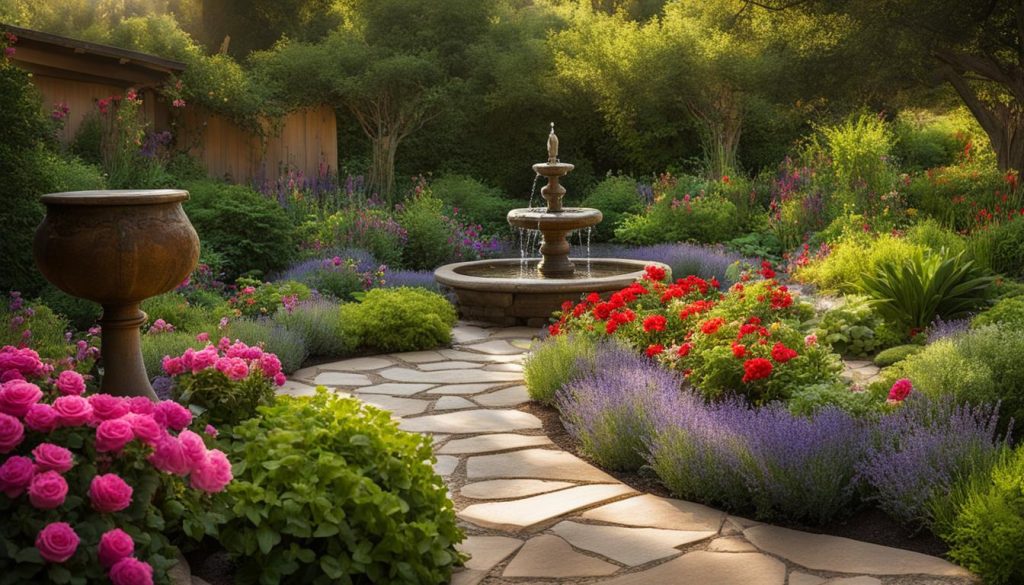Welcome to our fragrant garden landscaping guide! There’s nothing quite like the sweet scent of blooming flowers and fresh foliage to enhance your outdoor oasis. In this section, we’ll show you how to create aromatic spaces in your garden and make it scent-sational with our expert tips and advice. Let’s get started!
Key Takeaways
- Creating a fragrant garden is all about strategically selecting the right plants.
- A sensory garden experience engages all your senses, including smell.
- Designated fragrance zones can enhance the scent journey in your garden.
- Maintaining your fragrant plants requires regular care and attention.
- Creating a nighttime fragrant garden adds an extra touch of magic to your outdoor space.
Choosing Fragrant Plants for Your Landscape
When it comes to fragrant garden landscaping, we believe that choosing the right plants is essential. The plants you choose will dictate the scents that will waft through your garden, so it’s crucial to choose carefully. Here are some of our top picks for fragrant plants that will add delightful aromas to your garden landscaping:
| Plant Name | Aroma |
|---|---|
| Lilac | Sweet, floral |
| Jasmine | Intensely sweet |
| Lavender | Herbaceous, calming |
| Honeysuckle | Soft, sweet |
| Rose | Floral, romantic |
These are just a few examples of fragrant plants that can make a significant impact on your garden’s aroma. Be sure to research different plants and experiment with combining scents to create your unique fragrant garden design.
Benefits of Fragrant Plants in Garden Landscaping
Not only do fragrant plants add delightful aromas to your garden, but they can also have other benefits. For example, some plants like lavender and chamomile have calming properties that can help create a relaxing atmosphere in your outdoor space. Other plants like peppermint and rosemary have pest-repelling properties, which can help keep your garden free of unwanted insects.
- Tip: When selecting fragrant plants, consider choosing varieties that bloom at different times of the year, so you can enjoy the fragrance all year round.
By choosing the right fragrant plants for your garden, you can create a stunning and aromatic outdoor space that you can enjoy for years to come.
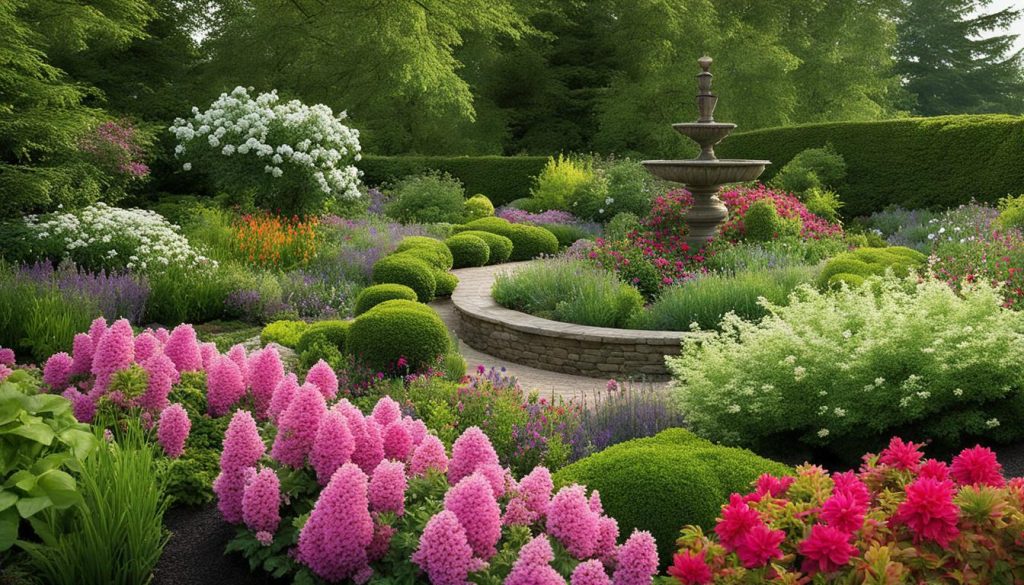
Creating a Sensory Garden Experience
When it comes to fragrant garden landscaping, creating a sensory garden can take your outdoor oasis to the next level. A sensory garden is designed to engage all your senses, including smell, creating a fragrant landscape that’s both beautiful and immersive.
The key to creating a successful sensory garden is strategic plant placement. Start by selecting plants that have a variety of fragrances, such as roses, lavender, and mint. Place these plants in locations where their scents can be easily experienced, such as along pathways or near seating areas.
You can also use different types of plants to create fragrance zones throughout your garden. For example, consider using lavender and thyme in one area and sweet alyssum and rosemary in another. This will create distinct scent areas that add interest and depth to your fragrant landscape.
Designing a Sensory Garden
When designing a sensory garden, consider incorporating elements that enhance your experience. For example, adding a water feature can create a soothing sound and help carry fragrances throughout the garden. A bench or seating area provides a peaceful spot to sit and take in the scents, while a trellis or archway can create a stunning entrance to your fragrant landscape.
You can also use texture and color to create a multi-dimensional sensory experience. Different types of foliage, such as fuzzy lamb’s ear or smooth rose petals, create a tactile experience. Bold and bright colors, like the red blooms of a rose bush, can create a visual focal point that draws your eye and complements the fragrant landscape.
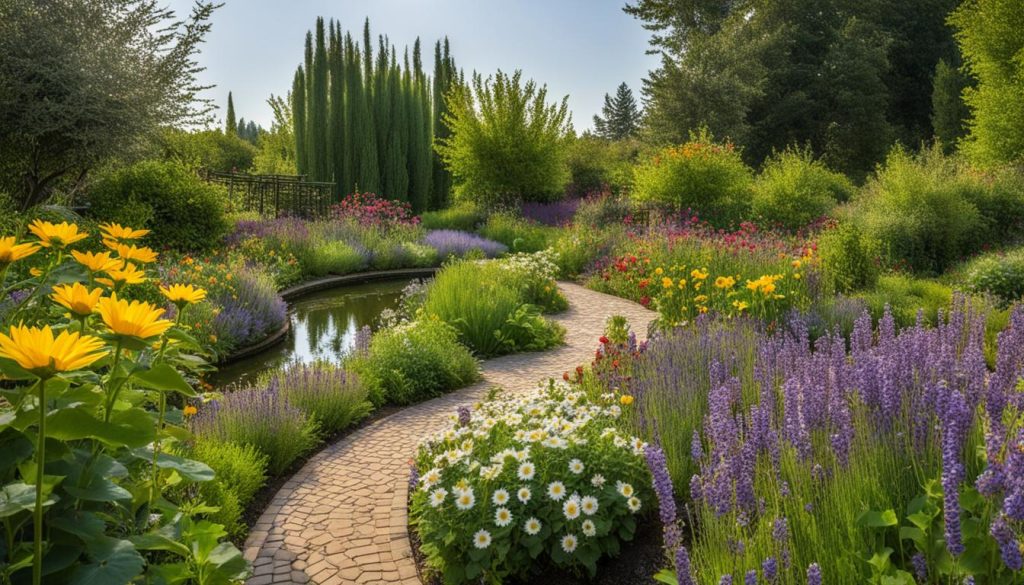
Ultimately, creating a sensory garden is about designing a space that engages all of your senses. By incorporating fragrance, texture, color, sound, and other elements, you can create a truly immersive outdoor oasis that’s both beautiful and fragrant.
Incorporating Aromatic Herbs in Your Garden
Herbs not only add delightful aromas to your garden but also provide fresh ingredients for cooking. In this section, we’ll show you how to incorporate aromatic herbs into your garden design. From lavender to rosemary, discover the best herbs to grow for both fragrance and culinary uses.
The Best Aromatic Herbs for Your Garden
When selecting aromatic herbs for your garden, it’s important to consider their scent, growth habits, and maintenance requirements. Here are some of the best herbs to grow for both fragrance and culinary uses:
| Herb | Botanical Name | Characteristics |
|---|---|---|
| Lavender | Lavandula spp. | Produces purple flowers and long-lasting fragrance. Drought-tolerant perennial plant. |
| Rosemary | Rosmarinus officinalis | A woody perennial herb with aromatic leaves. Tolerates dry, hot conditions. |
| Thyme | Thymus vulgaris | Small, evergreen herb with purple flowers. Needs well-draining soil and full sun. |
| Mint | Mentha spp. | Fast-growing herb with a refreshing scent. Prefers moist soil and partial shade. |
These herbs can be grown in containers or directly in the ground, depending on your garden’s design and layout. Consider incorporating them into your garden beds or placing them in strategic locations, such as near pathways or seating areas.
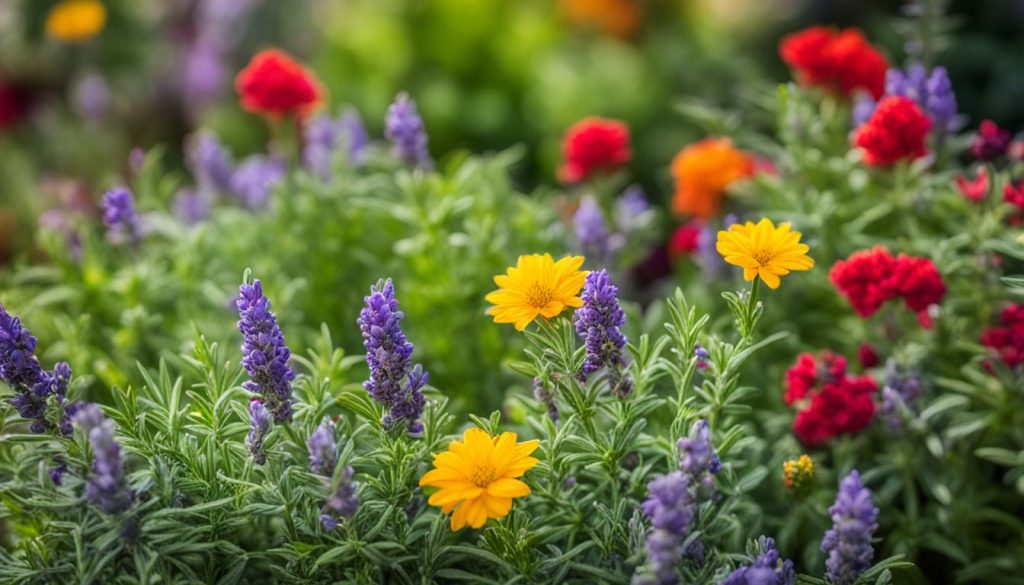
How to Care for Your Aromatic Herbs
To ensure that your aromatic herbs thrive in your garden, it’s important to care for them properly. Here are some essential tips:
- Water your herbs regularly, but be careful not to overwater them, as this can lead to root rot.
- Prune your herbs regularly to keep them from becoming too woody and to encourage new growth.
- Fertilize your herbs with a balanced fertilizer every few months to promote healthy growth.
- Harvest your herbs frequently to promote new growth and to ensure that they don’t become too leggy.
By incorporating aromatic herbs into your garden and caring for them properly, you can create a fragrant and functional outdoor space that will delight all your senses.
Designing Fragrance Zones in Your Outdoor Oasis
Creating designated fragrance zones in your garden can elevate your sensory experience to a whole new level. It allows you to enjoy different scents in separate areas of your outdoor oasis, adding depth and complexity to the overall ambiance. Follow our expert tips on how to design fragrance zones and make your garden scent-sational:
Location, Location, Location
Start by identifying the right location for your fragrance zones. Consider factors such as wind direction and sunlight exposure, which can affect the dispersal of scents. For example, you may want to place your fragrant plants in areas where the breeze can carry their scent towards seating areas or outdoor dining spots.
The Power of Contrast
Creating contrast between fragrance zones can make them even more impactful. Use a variety of plant types and scents in each zone to create a unique olfactory experience. For example, if you have a lavender zone, consider placing it next to a rose zone for a beautiful contrast of floral aromas.
Garden Paths and Seating Areas
Design your fragrance zones around garden paths and seating areas to maximize their impact. Consider using pathways to connect different zones and create a scent journey through your garden. Use seating areas strategically, placing them in areas where the scents are strongest, so that you can sit back and fully enjoy the fragrant garden.
Visual Appeal
Creating visual appeal for your fragrance zones is just as important as the scent itself. Use a combination of colors, textures and shapes to create an eye-catching display. Consider using a mix of flowering and non-flowering plants, or create a focal point with a stunning container garden. Don’t forget to add a touch of lighting to highlight your fragrance zones in the evening.
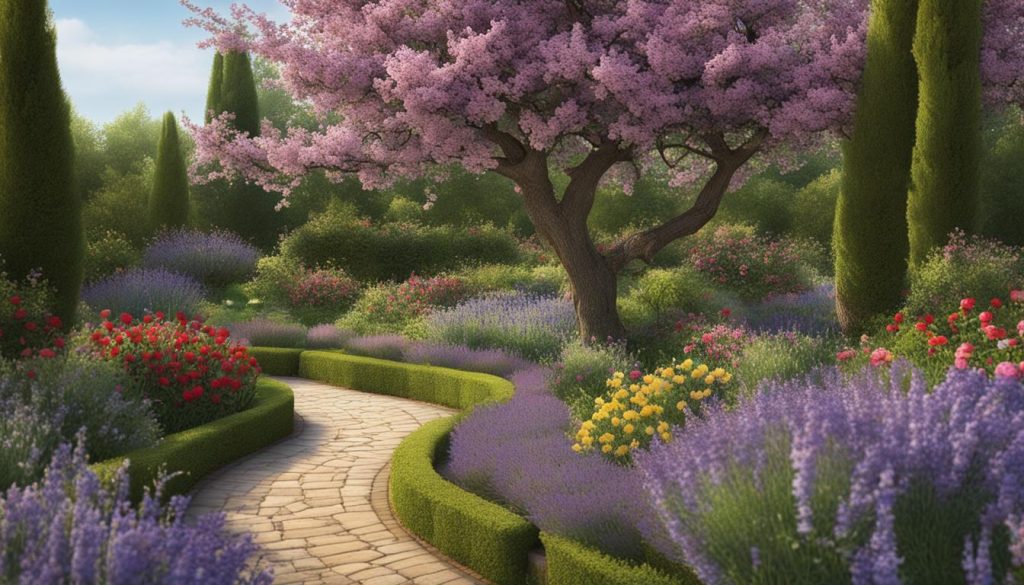
Designing fragrance zones in your outdoor oasis requires careful planning and execution, but the results are well worth it. Follow our tips and create a garden that not only looks beautiful but also smells absolutely divine.
Maintaining the Fragrance in Your Garden
After putting in all the hard work to create a fragrant garden, it’s important to keep your plants healthy and maintain their delightful scents. Here are some essential tips for fragrance maintenance and garden care:
Watering:
Proper watering is crucial for the health of your fragrant plants. Be sure to water them regularly, especially during dry spells. However, avoid over-watering as it can lead to root rot and other issues. Check the soil moisture level before watering and adjust accordingly.
Pruning:
Pruning is an important aspect of garden care that helps keep your plants healthy and promotes their growth. Deadhead spent blossoms to encourage new growth and remove any diseased or damaged foliage. Prune shrubs and trees that have outgrown their space to maintain their shape and size.
Fertilizing:
Fertilizing provides your plants with essential nutrients that promote healthy growth and vibrant blooms. Use a high-quality fertilizer that is suitable for the specific type of fragrant plant you are growing. Follow the instructions carefully to avoid over-fertilizing, which can damage your plants instead of helping them thrive.
Pest Control:
Pests can be a major problem for fragrant plants, so it’s important to take preventive measures to keep them at bay. Regularly inspect your plants for signs of pests and treat them promptly if you detect any issues. Use insecticidal soap or other environmentally friendly pest control methods to avoid harming beneficial insects.
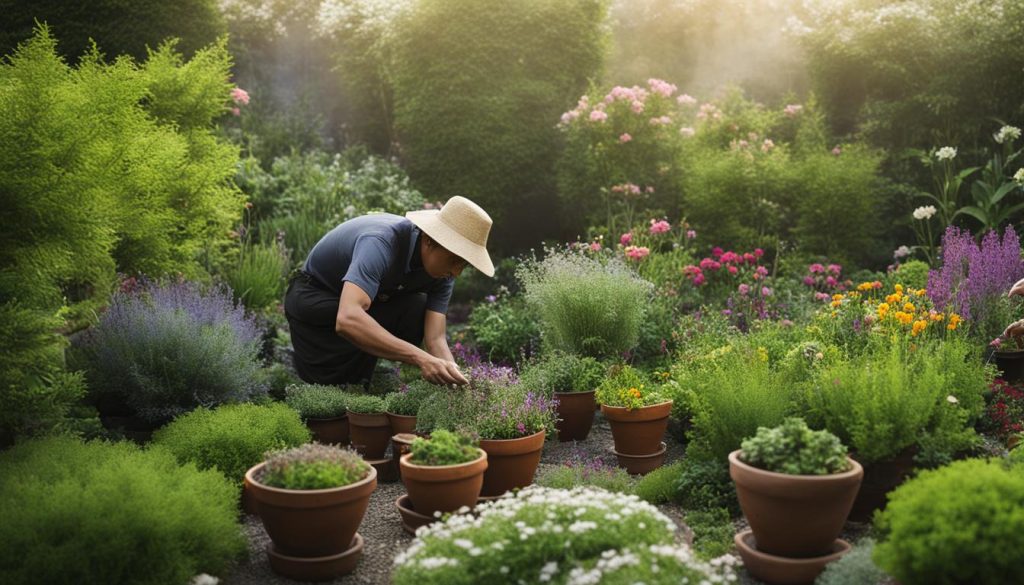
By following these tips for fragrance maintenance and garden care, you can ensure that your fragrant garden remains healthy and continues to emit captivating scents throughout the seasons. And remember, a little bit of regular care goes a long way in creating an aromatic oasis that you can enjoy for years to come.
Creating a Nighttime Fragrant Garden
As the sun sets, your garden doesn’t have to fade away. In fact, it can come alive with fragrance and beauty. A nighttime fragrant garden is a unique experience that you can create in your own backyard. Imagine walking through your garden in the evening and smelling the sweet scents of night-blooming flowers. It’s a sensory journey that everyone should experience.
To create a nighttime fragrant garden, you need to incorporate plants that release their scent after sunset. These are typically night-blooming flowers such as jasmine, moonflower, and night phlox. These plants don’t just smell amazing, but also add an enchanting touch to your garden with their delicate blooms.
When designing your nighttime fragrant garden, it’s important to consider lighting. You’ll want to showcase your fragrant plants while also creating a magical atmosphere. Consider using fairy lights, lanterns, or candles to create a soft glow that highlights your plants. You can also install low-voltage landscape lighting to help guide your way through the garden.
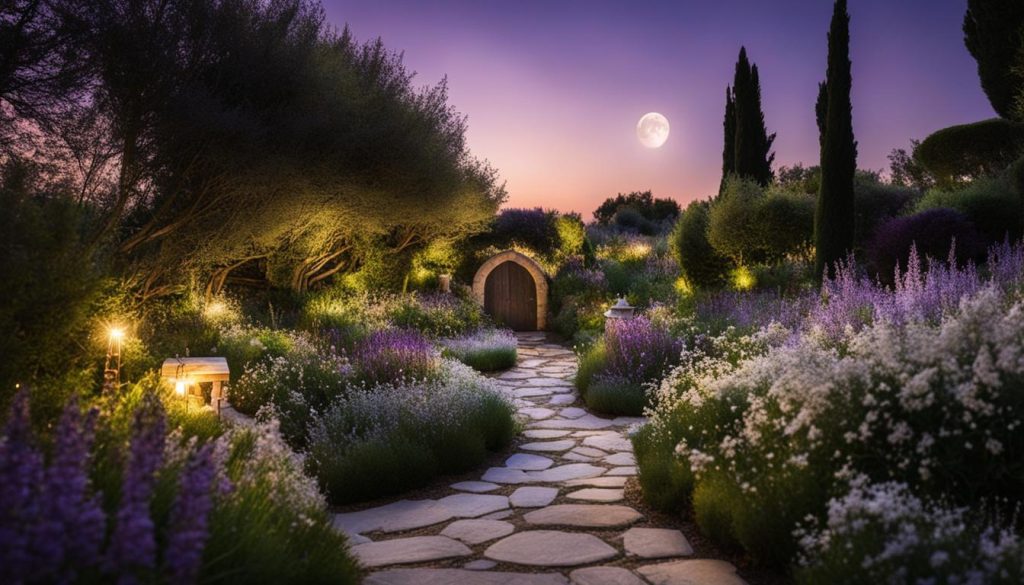
Another way to enhance your nighttime fragrant garden is by arranging plants strategically. Create pathways that lead to your fragrant plants and consider adding seating areas where you can sit and enjoy the scents. You can also use ornamental grasses to create a sense of movement and add texture to your garden.
With a nighttime fragrant garden, you can transform your outdoor space into a magical oasis that engages all your senses. The scents of night-blooming flowers and the soft glow of lighting will create an enchanting ambiance that you’ll love to spend time in.
Transforming Your Garden into an Aromatic Haven
By now, you have learned all about fragrant garden landscaping, selecting the best fragrant plants, creating a sensory garden experience, incorporating aromatic herbs, designing fragrance zones, maintaining the fragrance in your garden, and creating a nighttime fragrant garden. With all this knowledge, you are ready to transform your garden into an aromatic haven!
First, start by reviewing your garden design and identifying areas where you can incorporate fragrance zones. Consider adding seating in those areas to allow you to relax and enjoy the aromas. You can even add pathways that lead to designated fragrance zones.
Designing Fragrance Zones
When designing fragrance zones, keep in mind the height and spread of the fragrant plants you want to showcase. Place taller plants at the back of the zone and smaller ones at the front. You can also add decorative elements such as trellises or fountains to enhance the fragrance experience.
Choosing Fragrant Plants
When selecting fragrant plants, choose ones that will bloom at different times of the year so that you can enjoy fragrant blooms all year round. Also, ensure that you select plants that are hardy in your region, so they thrive in your garden.
Adding Aromatic Herbs
Incorporate aromatic herbs for their scent and culinary uses. They are perfect for fragrance zones near outdoor kitchens or dining areas. You can use herbs such as basil, thyme, and rosemary to add fragrance and flavor to your dishes.
Nighttime Fragrant Garden
Don’t forget to design a nighttime fragrant garden! Incorporate night-blooming flowers such as jasmine and moonflowers to emit captivating scents after sunset. Use lighting techniques such as string lights or lanterns to create an enchanting ambiance for nighttime enjoyment.
With these tips, your garden will become an aromatic haven that you can enjoy all year round. Remember to maintain your fragrant plants by providing them with the care they need to thrive. Happy gardening!
Feel free to reach out; our team is always delighted to assist with any questions you may have.
FAQ
How can I create a fragrant garden?
To create a fragrant garden, you can start by choosing the right plants that emit delightful scents. Consider incorporating flowers, shrubs, and herbs known for their aromatic properties. Additionally, strategically placing these fragrant plants throughout your garden can help maximize their scents.
What are some fragrant plants that I can add to my landscape?
There are numerous fragrant plants you can add to your landscape. Some popular options include roses, lavender, jasmine, honeysuckle, lilacs, and gardenias. These plants not only add beautiful scents but also enhance the overall ambiance of your outdoor space.
How can I create a sensory garden experience?
To create a sensory garden experience, you can strategically arrange fragrant plants throughout your landscape. Consider placing them near seating areas or along pathways where their scents can be easily enjoyed. Creating a variety of fragrance zones throughout your garden will engage all your senses and create a truly immersive experience.
Can I incorporate aromatic herbs into my garden?
Absolutely! Aromatic herbs not only add delightful scents to your garden but also provide fresh ingredients for cooking. Some popular aromatic herbs include rosemary, basil, thyme, mint, and sage. By incorporating these herbs into your garden design, you can enjoy their fragrance and use them in your culinary adventures.
How can I design fragrance zones in my garden?
To design fragrance zones in your garden, you can consider creating specific areas where scents can be experienced to the fullest. This can be done by strategically placing fragrant plants, incorporating seating areas, and designing pathways that lead to different aromatic spots. The goal is to create a journey of scents throughout your outdoor oasis.
How do I maintain the fragrance in my garden?
Maintaining the fragrance in your garden requires regular care and attention. Proper watering, pruning techniques, and fertilization are essential to keep your fragrant plants healthy and thriving. Additionally, removing any dead flowers or leaves will help prevent any unpleasant odors from developing.
Can I create a nighttime fragrant garden?
Yes, you can create a nighttime fragrant garden by incorporating night-blooming flowers and fragrant plants that release their scents after sunset. These plants, such as moonflowers, night-scented stock, and night-blooming jasmine, will add an enchanting ambiance to your outdoor space. Consider using lighting techniques to further enhance the nighttime fragrance experience.
How can I transform my garden into an aromatic haven?
To transform your garden into an aromatic haven, you can start by carefully selecting fragrant plants that suit your preferences and climate. From there, design fragrance zones, maintain the plants’ scents through proper care, and consider incorporating nighttime fragrant elements for an added touch of magic. By following these steps, you can create a garden that not only looks beautiful but also smells absolutely divine.

